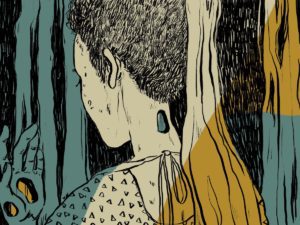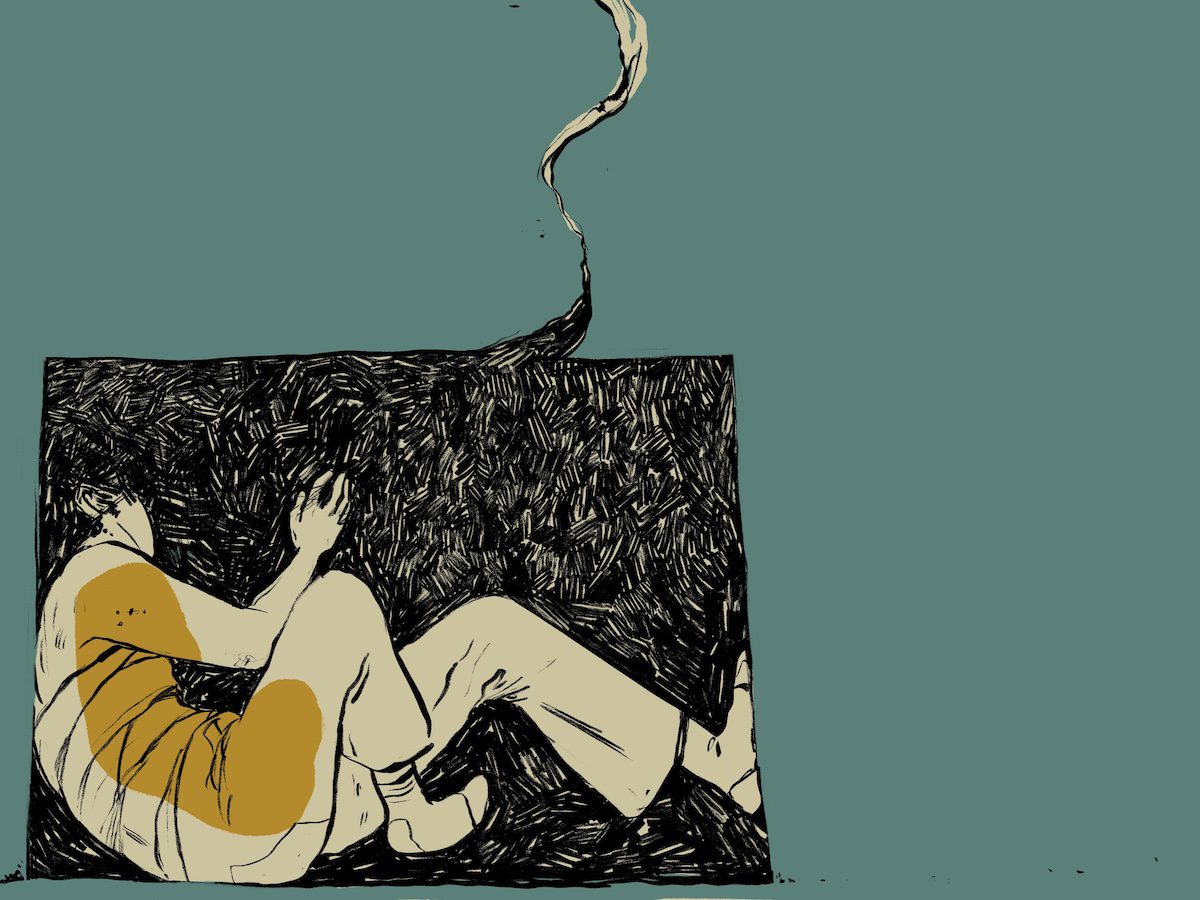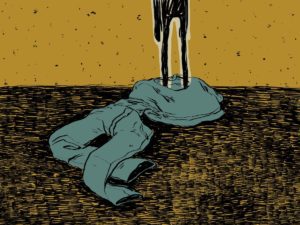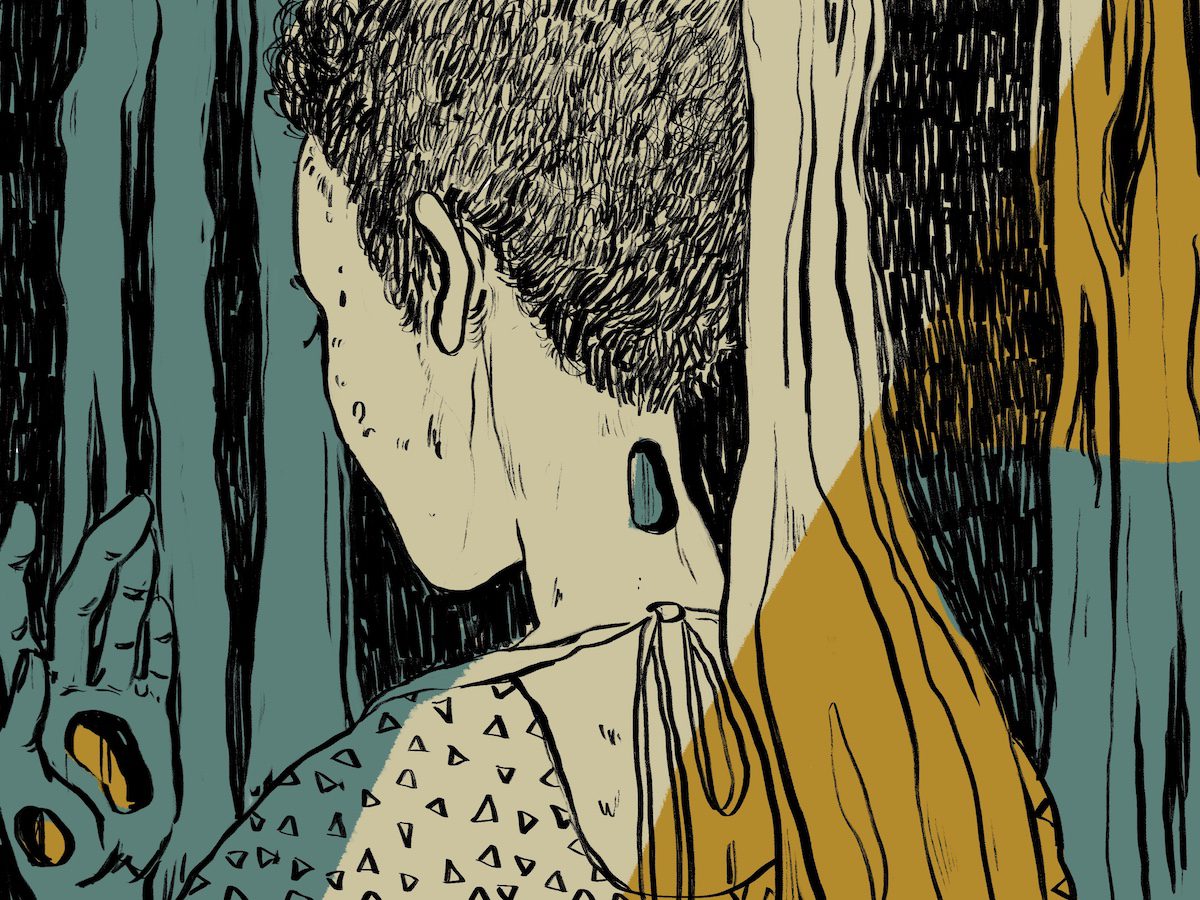
A year ago, my then-boyfriend-now-girlfriend Emily and I looked into a mirror together. I stood beside her, my five-foot-one nestled against her five-foot-six, our backlit frames staring at us in our apartment’s pre-installed floor-to-ceiling mirror. Simultaneously, we declared that we looked like aliens. Despite being able to feel our arms moving, we could not recognize who was waving back at us.
Every time my body moves, there is a gender attached. Leaning this direction means people will see me as a woman. An eyebrow raised this direction means people will see me as a man. I can tilt my laptop screen and watch the holograph shift: woman to man to woman to man to unknown. I catch myself rolling my shoulders inward to pretend I am more masculine while I am alone. Perhaps this is to avoid awkward situations, to prove something to someone, to grow myself larger even when I am uncomfortable in an act of resistance against my body. More than likely, though, my miniscule masculine adjustments resonate from deep within the crumbling fronds of my cerebellum.
My brain has tabs on my body at all times. Where my eyes are flickering against the edges of their sockets, the X, Y, and Z axes of my stomach in my shirt, my arms pressed in tensely against my side. Proprioception, the true sixth sense, tells me where my body is in space. It has sleeper agents in all of the parts of my body that move: muscles, tendons, and joints send signals up my spine, into the cerebellum, and through the posterior parietal cortex. It is just as unconscious as it is conscious.
I have been told to never expect to feel right in my body again, that anorexia breaks a bone that will never heal, always rubbing marrow against shards of beach-glass worn smooth by time. I have been stuck in a sling for years. As my thighs flatten against the chair I settle into, my awareness of my shape grows with the surface area squared. I zero in on the motion, feeling two separate pulls into the discomfort: I am hunched over, pushing my stomach into rolls; my head is tilted down slightly, creating the illusion of a double chin; my shoulders are pulled in from the sides, making my already-too-narrow horizon look smaller. I need to be both smaller and larger all at once.
Despite the dense network of cells that work together to keep us upright and aware, the brain is easily tricked by what it thinks is going on with the body. It sees what it wants to and assumes the rest.
Without proprioception, I have no way of interacting with the world around me, no internal guide to move through the outside world. Everyone else sees us without our neurological context. Sometimes, that difference between internal and external selves creates a conflict: gender dysphoria. When our prepackaged genitalia-and-gender combination does not align with our psychologically grounded gender, the dissonance expands. This can manifest in as many ways as a person interacts with the world, from the toys we chose to play with as a child to anxiety about the size of our hips to the shadows of thrice-shaven-raw beards. I didn’t realize people are supposed to relate to characters in movies, because I only related to the boys but I couldn’t because everyone had told me that I’m a girl, so I stopped watching movies because I thought I just didn’t understand them. In essence, we live in a state of low-level dissociation from life for years before someone finally tells us that there is a word for what we are: transgender.
I told myself at first that I couldn’t be trans because I was in a sorority. Because I’d been doing my eyeliner with thick wings for years, and because the compliments I got for them made me proud. Because I’d spent years focused on making myself as small, frail, and feminine as possible. Never more than a couple hundred calories a day, I’d promised, and held fast. But those were only symptoms, cultural hyperfemininity, believing what I’d seen was going to make me feel competent in a womanhood I wasn’t supposed to have been born into.
To call myself transgender with three syllables feels too heavy. Like if I can cut it down to just trans, keeping both my figure and my identity trim, it doesn’t mean the same thing anymore. In a way, it doesn’t. To be trans is to be transcendent, transgressive, and transmogrified, but it is also translucent, transected, and transformed. It makes sense then that dysphoria and dysmorphia sound so similar: dysphoria, as in an unease or dissatisfaction, versus dysmorphia, as in unreal deformity or abnormality. While gender dysphoria feels awful, addressing the issue directly through transition makes it better. Transitioning hopes to bring the body up to speed with the brain in a proprioceptive recalibration. I have to know what and where and why my body is. Addressing body dysmorphia, on the other hand, can lead to eating disorders in a misguided attempt to cure the ache of a body that feels unknowably wrong.
While chronically understudied, like most of the field of trans health, we do know that trans people suffer from eating disorders at absurdly high rates. A study by Elizabeth Diemer and her colleagues in 2015 showed that trans college students are five times more likely to have clinical diagnoses and suffer from self-reported disordered eating behaviors than our cisgender counterparts. Almost sixteen percent of transgender people, straight and queer, suffered. Everywhere you turn: weak hair, bruised knuckles, unfocused eyes. Cisgender heterosexual women, the gold standard of eating disorder imagery, suffered at a rate of less than two percent. The image of a white female model hunched over herself, each spinal vertebrae cracking her thin, downy skin, the image I desperately tried to reflect. The next largest category after trans students in Diemer’s study was cisgender gay men, who averaged a less than a quarter of trans rates in all categories.
The Trevor Project, the National Eating Disorders Association (NEDA), and Reasons Eating Disorder Center worked together to publish a comprehensive study on the mental health of LGBTQ+ youth at the end of 2017. Among the kids they talked to, over half had been diagnosed with an eating disorder. Another quarter suspected they had one but had never been formally diagnosed. Seventy-five percent of queer kids starve themselves or force themselves to vomit regularly.
Though sexual minority versus gender minority was never broken down in any visible statistic in this 2017 study, Diemer’s 2015 study makes it easy to assume that an unnervingly large percent of them are transgender. When I checked in for outpatient therapy for anorexia at barely-scraping-twelve-years-old, I assumed that I was part of the aforementioned gold standard. When I told my therapist that I thought I was probably, maybe, I don’t know, trans at barely-scraping-twenty-two, she nodded and quietly added that she’d been told, “most trans people raised as women have eating disorders at some point or another.”
Our bodies’ behavior in space is not one of those things that is easy to tune out once it’s been noticed, like how mechanical blinking feels or how deep lungs can fill into the abdomen. Or like realizing that some part of yourself has been missing this entire time.
If I were to stare into a mirror, I’m not sure I would see anything back.
It’s become hard to eat yet again in a way eerily reminiscent of the past. It’s because I cut my hair, because I started binding my chest, because now the top half of me is starting to look like I didn’t know I wanted and I’m more aware of the space that my hips take up. My fat matrix, laid out like shark teeth, lingers just below the surface.
Anorexia nervosa is a pithy attempt at grabbing control with brittle fingernails when we otherwise feel our bodies spiraling. We use starvation to make our felt space feel smaller when we feel bigger than ourselves, and then it becomes an addiction. We convince ourselves that colors are brighter and we smile bigger when we go to sleep hungry and wake up hungrier and snap a rubber band around our wrist to convince ourselves at lunch that we are not. It is about feeling better about ourselves while our mother sits on the floor, surrounded by haphazardly thrown cookbooks, sobbing that it was her fault when only anorexia itself is to blame.
While in the throes of illness, our understanding of where we are in space malfunctions. We have compromised our sense of ourselves, of the way our skin presses against bone and melts, on a neurological level. What we have been stuffed into is not something that we can recognize, growing and shrinking with every thought like a brick wall on psychedelics. Every fat cell breathes, and nothing that anyone can say or do changes this fact while we’re starving. After we’re done waking up at 3 a.m. to do silent aerobics on our bedroom floors, our spatial awareness and hard-won bodies recover. Our disrupted sense of hunger, however, never fully realigns itself.
What happens when the silent understanding between the body and the brain fringes? What happens when it all falls apart?
My officemate tells me twice, over the course of several months where I am stuck between ideas of gender like dust between cogs, that she can always hear my crunching behind her while she works. Horrified, I stop eating on campus. I stop eating in places where others can see it, can hear it, can know, because being caught eating is a fate worse than death. It is not the first time that I’ve felt this way, but it started coming back when not being a woman became a distinct possibility.
The commonality and camouflaging of eating disorders amongst trans people is disturbing, but no one has any solid theories as to why it may happen. It may be the feminization of starvation. Female bodies are supposed to be small, supposed to fit the model of the one type of acceptable femininity in the media. Women are more susceptible, then, to try to fit what culture says they’re supposed to be. When you’re not sure if you’re a woman or not, trying to fit a predetermined mold is a way to normalize your own existence. Long-term starvation destroys muscle mass, a common point of dysphoria for trans women, as well as fat, a common point of dysphoria for trans men. It’s a win-win scenario, minus the kidney and heart damage and one in five chance of dying. I didn’t anticipate being part of the four who survive. Trying to make a life for myself in the aftermath forced me to stare at my unknowable reflection.
The first time I saw the thumbnail-sized vial of testosterone cypionate, I realized it is clear. I don’t know why I thought it would be gold, but it’s not.
A common theory for the origin of eating disorders is that of control, a desperate attempt to cling to something. A general lack of control may create the feeling that weight and food are the only two things we can control. It’s terrifying to realize you have a gender identity that doesn’t line up with what you were told it had to. It gets worse when you’re unsure of your sexuality and everything feels up in the air, with no idea who you can turn to for support. It is no surprise, then, that more than one in four trans people who may be sexual minorities have clinical eating disorders. I started questioning if I was bi the same year I stopped eating the first time. I had to balance the weight of thoughts.
Twelve years old, the year I don’t really remember, featured both my first boyfriend and my first real crush on a girl. The memories come back in fragments: shattered glimpses of her smiling in the April sunshine, five foot one to match my height exactly, walking slowly alongside me to my left. Dropping my loud paper bag lunch in the trash every day off my right. Standing on benches, looming over my thirteen-year-old boyfriend, asking him if every man thought it would be better to be a woman like every woman thought it would be better to be a man. Watching the horror grow in his face, like he knew something I didn’t. It didn’t matter who knew anything until it did.
There are multiple scales that try to quantify our feelings of confusion and lack of control and hatred, designed to label your dissatisfaction and pin it down to something that can be tabbed through in Excel. There are drawings of male and female cisgendered bodies, stereotypical shapes in black and white, littered across the Internet. Sometimes, I sit and stare at them all splayed across one page and try to place myself. I am a women’s size ten and want to be a men’s 28×30. I am here and I want to be there. Like maybe I can cover myself in hand-drawn lines to refocus where I need to be. Like maybe somewhere beneath all of this body, there is something worthy of being real. Like maybe somewhere under all of these expectations I have covered myself in, there is something already real.
Eating disorders lie and keep us in the dark on purpose, but gender identity tells the truth. The sense of relief that we have in amending our external gender presentation is something unique to the trans experience. Eventually, with enough time and hormones and practice, we can see who we always knew we were. I scour my face in the mirror, hunting for bits of newfound masculinity, and smile when I see it.
Sometimes, I eat a pint of chocolate peanut butter ice cream in one sitting and don’t feel a thing. Sometimes, I buy a pint of sugar-free sorbet and throw it away on the walk home. Sometimes, I dissolve four Oreos under my tongue and spend an hour sobbing over the toilet because I can’t get them to come up. These are three different people. They all live in unison, overlapping shadows in the gyri of my prefrontal cortex.
“You are okay,” I tell my mirror. “You are here, you are real, you are enough. You are okay.” If I continue to practice, maybe one day I will be able to see myself in the mirror as I am.
***
Rumpus original art by Eva Azenaro Acero.







